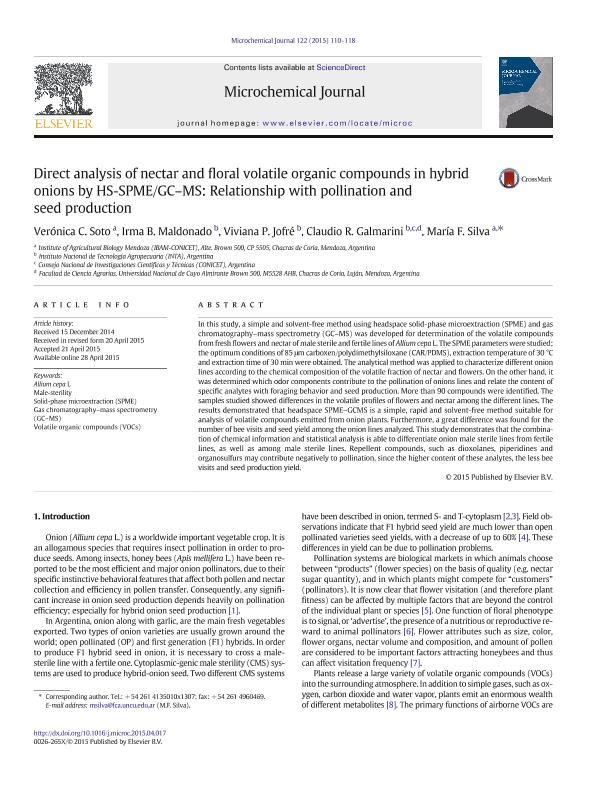Mostrar el registro sencillo del ítem
dc.contributor.author
Soto Vargas, Verónica Carolina

dc.contributor.author
Maldonado, Irma B.
dc.contributor.author
Jofre, Viviana Patricia

dc.contributor.author
Galmarini, Claudio Romulo

dc.contributor.author
Silva, María Fernanda

dc.date.available
2018-03-26T20:36:43Z
dc.date.issued
2015-09
dc.identifier.citation
Soto Vargas, Verónica Carolina; Maldonado, Irma B.; Jofre, Viviana Patricia; Galmarini, Claudio Romulo; Silva, María Fernanda; Direct analysis of nectar and floral volatile organic compounds in hybrid onions by HS-SPME/GC-MS: Relationship with pollination and seed production; Elsevier Science; Microchemical Journal; 122; 9-2015; 110-118
dc.identifier.issn
0026-265X
dc.identifier.uri
http://hdl.handle.net/11336/40046
dc.description.abstract
In this study, a simple and solvent-free method using headspace solid-phase microextraction (SPME) and gas chromatography-mass spectrometry (GC-MS) was developed for determination of the volatile compounds from fresh flowers and nectar of male sterile and fertile lines of Allium cepa L. The SPME parameters were studied; the optimum conditions of 85. μm carboxen/polydimethylsiloxane (CAR/PDMS), extraction temperature of 30. °C and extraction time of 30. min were obtained. The analytical method was applied to characterize different onion lines according to the chemical composition of the volatile fraction of nectar and flowers. On the other hand, it was determined which odor components contribute to the pollination of onions lines and relate the content of specific analytes with foraging behavior and seed production. More than 90 compounds were identified. The samples studied showed differences in the volatile profiles of flowers and nectar among the different lines. The results demonstrated that headspace SPME-GCMS is a simple, rapid and solvent-free method suitable for analysis of volatile compounds emitted from onion plants. Furthermore, a great difference was found for the number of bee visits and seed yield among the onion lines analyzed. This study demonstrates that the combination of chemical information and statistical analysis is able to differentiate onion male sterile lines from fertile lines, as well as among male sterile lines. Repellent compounds, such as dioxolanes, piperidines and organosulfurs may contribute negatively to pollination, since the higher content of these analytes, the less bee visits and seed production yield.
dc.format
application/pdf
dc.language.iso
eng
dc.publisher
Elsevier Science

dc.rights
info:eu-repo/semantics/openAccess
dc.rights.uri
https://creativecommons.org/licenses/by-nc-sa/2.5/ar/
dc.subject
Allium Cepa L
dc.subject
Gas Chromatography-Mass Spectrometry (Gc-Ms)
dc.subject
Male-Sterility
dc.subject
Solid-Phase Microextraction (Spme)
dc.subject
Volatile Organic Compounds (Vocs)
dc.subject.classification
Agricultura

dc.subject.classification
Agricultura, Silvicultura y Pesca

dc.subject.classification
CIENCIAS AGRÍCOLAS

dc.title
Direct analysis of nectar and floral volatile organic compounds in hybrid onions by HS-SPME/GC-MS: Relationship with pollination and seed production
dc.type
info:eu-repo/semantics/article
dc.type
info:ar-repo/semantics/artículo
dc.type
info:eu-repo/semantics/publishedVersion
dc.date.updated
2018-03-23T18:20:24Z
dc.journal.volume
122
dc.journal.pagination
110-118
dc.journal.pais
Países Bajos

dc.journal.ciudad
Amsterdam
dc.description.fil
Fil: Soto Vargas, Verónica Carolina. Consejo Nacional de Investigaciones Científicas y Técnicas. Centro Científico Tecnológico Conicet - Mendoza. Instituto de Biología Agrícola de Mendoza. Universidad Nacional de Cuyo. Facultad de Ciencias Agrarias. Instituto de Biología Agrícola de Mendoza; Argentina
dc.description.fil
Fil: Maldonado, Irma B.. Instituto Nacional de Tecnología Agropecuaria; Argentina
dc.description.fil
Fil: Jofre, Viviana Patricia. Instituto Nacional de Tecnología Agropecuaria; Argentina
dc.description.fil
Fil: Galmarini, Claudio Romulo. Instituto Nacional de Tecnología Agropecuaria; Argentina. Consejo Nacional de Investigaciones Científicas y Técnicas. Centro Científico Tecnológico Conicet - Mendoza; Argentina. Universidad Nacional de Cuyo. Facultad de Ciencias Agrarias; Argentina
dc.description.fil
Fil: Silva, María Fernanda. Consejo Nacional de Investigaciones Científicas y Técnicas. Centro Científico Tecnológico Conicet - Mendoza. Instituto de Biología Agrícola de Mendoza. Universidad Nacional de Cuyo. Facultad de Ciencias Agrarias. Instituto de Biología Agrícola de Mendoza; Argentina
dc.journal.title
Microchemical Journal

dc.relation.alternativeid
info:eu-repo/semantics/altIdentifier/url/https://www.sciencedirect.com/science/article/pii/S0026265X15000788
dc.relation.alternativeid
info:eu-repo/semantics/altIdentifier/doi/http://dx.doi.org/10.1016/j.microc.2015.04.017
Archivos asociados
